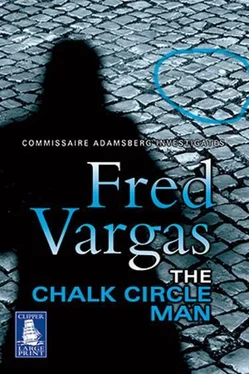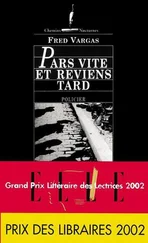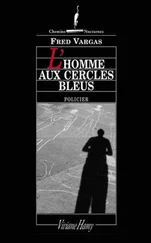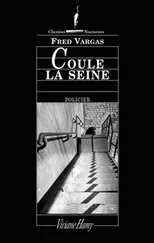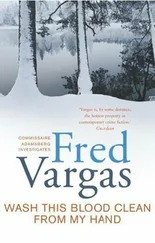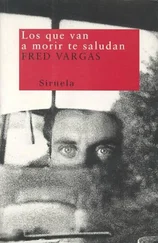While Conti was snapping away, Danglard reflected all the same that Adamsberg had put him in a slightly ridiculous situation. If any local policeman should come past, he’d be right to say that the 5th arrondissement station was going round the bend if it had taken to photographing watch straps. And Danglard did feel that the 5th was indeed heading round the bend, himself along with the rest. What was more, he still hadn’t tied up everything on the Patrice Vernoux case, which he ought to have done first thing. His colleague Castreau was probably wondering by now where he’d got to.
In the rue Froidevaux, at the junction with the rue Emile-Richard, the lugubrious and narrow passage running through the middle of the Montparnasse cemetery, Danglard understood why the woman had complained, and was almost relieved to discover the reason.
Yes, it had got bigger.
‘See that?’ he said to Conti.
In front of them, the blue circle surrounded the remains of a cat that had been run over. There was no blood: the cat had obviously been picked out of the gutter where it had been dead for hours. Now it just looked morbid, a bundle of dirty fur in this sinister street, with the circle and the inscription ‘Victor, woe’s in store, what are you out here for?’ It made him think of some kind of weird witches’ spell.
‘All finished,’ said Conti.
Stupid, perhaps, but Danglard sensed that Conti was a bit impressed.
‘I’ve finished too,’ said Danglard. ‘Come on, back to base before the locals find us on their patch.’
‘Yeah, right,’ said Conti. ‘We’d look pretty silly.’
Adamsberg listened to Danglard’s report impassively, allowing his cigarette to droop from his lips, screwing up his eyes to keep the smoke out of them. The only movement he made throughout was to bite off a piece of fingernail. And as Danglard was beginning to get the measure of his character, he realised that Adamsberg had assessed the discovery in the rue Froidevaux at its true value.
But what was that, exactly? For the moment, Danglard had no idea. The way Adamsberg’s mind worked was still enigmatic and impressive to him. Sometimes, but only for a second, he thought: Keep your distance.
But he knew the moment the report went round the station that the boss was wasting his own and his inspectors’ time on the chalk circle man, Danglard would have to defend him. And he was trying to prepare his defence.
‘Yesterday a mouse,’ said Danglard, as if talking to himself, practising future explanations to his colleagues. ‘And now a cat. It’s a bit nasty, yes. But there was the watch strap as well. And as Conti rightly pointed out, the watch strap wasn’t dead.’
‘It was dead all right,’ said Adamsberg. ‘Of course it was! Same thing tomorrow morning, Danglard. I’m going to see this psychiatrist who’s taken up the affair, Vercors-Laury. I’d be interested to hear what he thinks. But don’t tell anyone. The later anyone asks what I’m up to, the better.’
Before leaving, Adamsberg wrote a note for Mathilde Forestier. It had taken him less than an hour to track down her Charles Reyer, after telephoning the main organisations that employed blind people in Paris: piano tuners, publishing houses, music schools. Reyer had been in the city several months, and was staying in a room near the Pantheon, at the Hôtel des Grands Hommes. Adamsberg sent the information to Mathilde, and promptly forgot about it.
Well, René Vercors-Laury isn’t all that impressive, was Adamsberg’s first reaction. He was disappointed in the psychiatrist, since he always set out feeling hopeful and disillusion was invariably painful.
Not impressive at all, in fact. And exasperating with it. The psychiatrist kept interrupting himself with questions like: ‘See what I mean?’, ‘You follow me?’ or statements such as: ‘You’ll agree with me, won’t you, that the Socratic method of suicide is not the only model?’ – without waiting for Adamsberg’s reply, since the intention was simply to show off. Vercors-Laury expended an inordinate amount of time and words showing off. The portly doctor would first lean back in his armchair, fingers clutching his belt, seeming to think deeply, and would then hurl himself forward to begin a sentence: ‘ Commissaire , this is no ordinary case.’
If one set all that aside, the man wasn’t lacking in intelligence; that much at least was clear. After the first quarter of an hour, things went better; still not impressive, perhaps, but better.
‘Our subject,’ said Vercors-Laury, launching into a peroration, ‘does not fit the normal pattern of subjects with a compulsive disorder, if you are asking for my clinical opinion. Compulsives are by definition compulsive , and one should never forget that – do you follow me?’
He was clearly highly satisfied with this formula. He went on:
‘And because they are compulsive, obsessive, they’re precise, careful, and ritualistic. You follow me? But what do we find with this subject? No ritual governing the choice of object, no ritual governing the choice of district, or the time of night, or even the number of circles to draw on any given night. So! You see the immense discrepancy? All the parameters of his actions vary unpredictably: object, place, time, quantity, as if they were entirely determined by chance circumstance. But, Commissaire Adamsberg, in the case of a compulsive personality nothing is determined by chance circumstance. Are you with me? And that is, in point of fact, the defining feature of the compulsive subject: he will make the chance circumstance bend to his will, rather than allow it to drive him. No contingency is strong enough to halt the relentless progress of his obsession. You see what I’m driving at?’
‘So what we have here is no common-or-garden crank? Not a compulsive personality at all?’
‘That’s right, commissaire , we could almost swear to it. And that opens up a whole field of inquiry. If we’re not dealing with an obsessive-compulsive personality in the clinical sense of the term, then the circles must be in pursuit of some aim which has been thoroughly thought through by their perpetrator, and our subject must have a genuine interest in the objects that he’s bringing to our attention, as if he meant to show us something. You follow me? Or to tell us something. For instance, that people don’t think enough about the objects they throw away. Once these objects have ceased to be useful, once they have served their purpose, our eyes don’t even see them as material any more. I could show you a pavement and say: “What do you see on the ground?” and you could reply: “Nothing.” Whereas in reality ‘ (heavy emphasis) ‘there are dozens of objects there. You follow? This man appears to be grappling with a painful investigation of some kind: metaphysical, philosophical, or perhaps – why not? – poetic, about the way human beings choose to make the reality of the material world start and stop, something for which he has elected himself the arbiter. Whereas in his eyes, it may be that material objects continue their existence outside our perception of them. My sole aim, when I took an interest in this man, was to say: Take care, don’t joke about this obsessive behaviour pattern, the chalk circle man may be someone of perfectly lucid mind, who cannot express himself except through these manifestations, which are, indeed, evidence of a mind in some sense deranged, yet at the same time highly organised, you follow? But someone of above average intelligence, believe me.’
‘But there are mistakes in the series. The mouse and then the cat, they weren’t objects.’
‘As I said, there’s much less logic to the series than might appear at first, the kind of logic we would find if this were a case of authentic obsession. That’s what’s so unsettling about it. But from the point of view of our subject, he is demonstrating that death transforms a living creature into an object the moment the lifeless body ceases to feel anything – which is true enough. From the instant the top comes off the bottle, the top becomes a non-thing. And when the body of a friend stops breathing – what does it become? Our man is preoccupied with questions of this order. In fact, not to put too fine a point on it: he’s obsessed with death.’
Читать дальше
